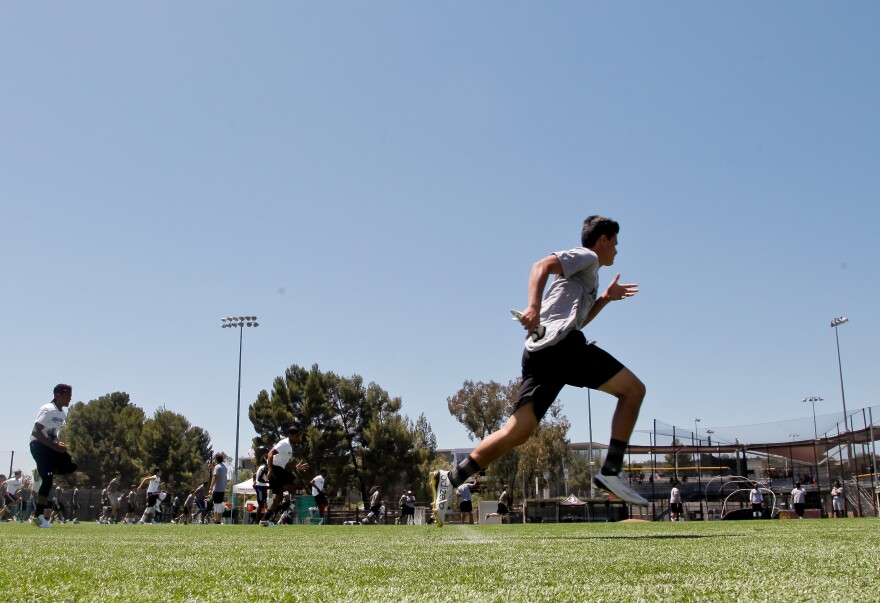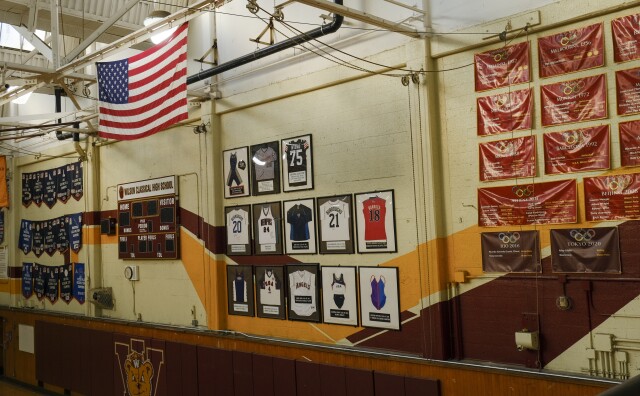California schools must now monitor the heat and adjust athletic practices and games according to new policies developed by the state's high school sports governing body and mandated by state law.
Heat was responsible for nearly 20% of high school and college athletic catastrophic injuries in the most recent year studied by researchers at the University of North Carolina. Dozens of high school athletes in the U.S. have died from heat-related illnesses in the last two decades.
“The goal is that we don't have any more fatalities due to what is an entirely 100% preventable issue, which is heat stress and heat related illness,” said Mike West, California Interscholastic Federation (CIF) Southern Section’s commissioner of athletics.
Districts have purchased new equipment and changed how and when student athletes practice to comply with the new policy.
“We're not against this policy,” said St. Francis High School head athletic trainer Eli Hallak. “We think it's the right thing to do. We just think there's some tweaks that need to happen to make it fair and equitable for all schools.”
A new way to measure temperature
California is now one of at least 25 states to require high school athletic programs to adapt to the heat.
-
Heat stroke is a potentially fatal heat-related illness and occurs when the body can no longer cool itself. The onset can be sudden or gradual and symptoms include:
- Headache
- Confusion, dizziness or slurred speech
- Loss of consciousness
- Hot, dry skin or profuse sweating
- Seizures
- Very high body temperature
- Muscle cramps
-
Learn more from the Centers for Disease Control and Prevention and the Korey Stringer Institute.
Essentially, the hotter the temperature, the more breaks players need and the less protective gear they can wear during practice. Games and practices must be moved or canceled when the temperature exceeds a certain threshold.
The state’s rules are based on two factors.
First: a reading from a Wet Bulb Globe Thermometer. The device measures how heat stresses the human body by calculating the impact of the temperature, humidity, wind, and strength of the sun.
A higher basic air temperature doesn’t necessarily correlate with a higher Wet Bulb Globe Thermometer reading.
“You can practice in a higher temperature, as long as that humidity is low and there's some wind,” West said. “Whereas, a lower temperature with higher humidity and the wind not being a factor, can really make things a little bit more unsafe.”
West said CIF provided grants this summer to help schools purchase the $750 to $800 thermometers. One manufacturer is offering a discounted kit to California schools though shipping is currently delayed because of high demand.
The second factor is based on the campus’s location. Schools are assigned one of three categories based on their region — most Los Angeles schools are in Category 1.
The guidelines describe the course of action at five different levels ranging from green (normal activity) to black (no outdoor workouts and events allowed). A school’s category determines the Wet Bulb Globe Thermometer temperature threshold for each level.
What does it look like in practice?
LAist talked to Hallak, earlier this week from his office at the all-boys Catholic high school in La Cañada where he's also the director of health services and sports medicine. He pulled up the readings from the campus’ weather station at around 4:30 p.m. on a sunny afternoon.
The basic air temperature was 86 degrees Fahrenheit. The Wet Bulb Globe Thermometer reading was 80.2 degrees Fahrenheit.
St. Francis, like most schools in the Los Angeles metro area, is considered “Category 1.” This put the school in the second, or yellow, level, which requires increasing the length of the three-times-an-hour rest breaks to four minutes and “using discretion” for long and intense practices.
The school has already shifted several workouts to comply with the heat illness guidelines and there’s a concern that pushing practice too far into the evening or early in the morning could disrupt students’ schedules or that they could miss valuable preparation time altogether.
Hallak said it’s not clear why a San Gabriel Valley school shares the same category as campuses in cooler coastal climes like Palos Verdes and Santa Monica. The school is requesting a change in designation from CIF. San Diego schools have raised similar concerns.
“Every athlete should have a chance to play, but play safely,” Hallak said.
-
How to check the weather at your child’s school: Find the forecast for their region on the National Weather Service website— choose “Wet Bulb Globe Temperature” from the dropdown menu at the top of the map.
-
Questions to ask your school:
- Do you have a Wet Bulb Globe Thermometer? If not, how are you monitoring the temperature?
- How are you monitoring air quality?
- What is the school’s emergency action plan for heat illness? Per state law, schools are required to write out procedures to follow if someone gets sick from the heat during an athletic event.
-
If you believe your child's team is violating the rules, first reach out to school and district administration. You can also escalate concerns to the CIF Southern Section.
-
Hallak, at St. Francis, also says parents should check in with their kids, particularly when they’re just starting a sport.
-
“You know your son better than most coaches, you know your daughter better than most coaches,” Hallak said. “Are they eating right? Are they drinking right? Are they rehydrating after practices?”
Other new rules this year include rescheduling sporting events during periods of low air quality and requiring schools to have emergency action plans for each athletic facility on campus.
CIF provided the new guidelines to all schools and is responsible for enforcing the new heat illness rules, but typically doesn’t investigate unless there is a complaint. Repeated, substantiated violations could result in fines, suspensions or other penalties to a school’s athletic program.








